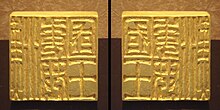Well (state)
Na ( Japanese 奴 国 Na-koku or Na no kuni , dt. "Land Na") was a Japanese state during the 1st to early 3rd century of the Yayoi period . It probably corresponds to the later administrative unit Na no Agata ( 儺 県 ) of the subsequent Yamato period at Hakata Bay ( 博 多 湾 ) in Fukuoka .
Historical records
The first mention is in Weizhi Worenchuan ( Chinese 魏志 倭人 傳 / 魏志 倭人 传 , W.-G. Wei-chih Wo-jen-chuan , Japanese 魏志 倭人 伝 , Gishi Wajinden , dt. "Records of Wei : Lives of the people of Wa ”), part of the Chronicles of the Three Kingdoms , and names for the Na of the 3rd century a. a. Names of officials and that it had a population of over 20,000 households - compared to the most powerful state of Yamatai with 70,000 households.
Perhaps the name Na-no-tsu ( 那 津 ) for Hakata Bay goes back to the name of the state and then means "Port of Na". The same “Na” occurs in the name of the Naka-gawa ( 那 珂川 ) river that flows into it .
Chinese seal

According to the Book of the Later Han , Emperor Guangwu of Han bestowed an imperial seal on Na in 57. There it says:
“In the second year [of the motto] chien-wu chung-yüan [= 57 oc] the Wo-Land Nu offered tribute and gave gifts to the court. The Messenger referred to himself as 'ta-fu'. It is the extreme southern limit of the Wo country. [The Emperor] Kuang-wu [right. 25-58] awarded a seal with a ribbon. "
The seal mentioned corresponds to the Chinese jade seal, but is made of gold with a square edge length of 2.3 cm each and a weight of 108 g.
In return, Na sent an embassy to the Chinese capital in the same year to give tribute and New Year's greetings. The gold seal ( 金 印 , kin'in ) was found by a farmer on Shika-no-shima in 1784 , which led to the verification of Na, otherwise known only from ancient sources. On this is the inscription "King of the land of Na von Wa von Han " (modern Kanji : 漢 委 奴 国王 , Kan no Wa no Na no koku-ō , Chinese Han Wei Nu guo wang ). "Wa of Han" is not necessarily to be understood here as meaning that Wa (Japan) would have been a vassal of Han (China), but can also mean "From the Han [given] the king ...".
The seal is now the Japanese national treasure and is kept in the Fukuoka City Museum.
Individual evidence
- ↑ Barbara Seyock: On the trail of the Eastern barbarians . Münster 2004, p. 199 .
- ↑ Translated by Barbara Seyock: On the trail of the Eastern barbarians . 2004, pp. 207-08
literature
- Barbara Seyock: On the trail of the Eastern barbarians. On the archeology of protohistoric cultures in South Korea and West Japan (= Bunka - Tübingen intercultural and linguistic studies of Japan . Volume 8 ). LIT Verlag, Münster 2004, ISBN 3-8258-7236-X , 3.6 Na, p. 199–211 ( limited preview in Google book search [accessed on April 27, 2013] dissertation at the University of Tübingen from 2002).
Web links
- Fukuoka City Museum website on the Gold Seal (Japanese)